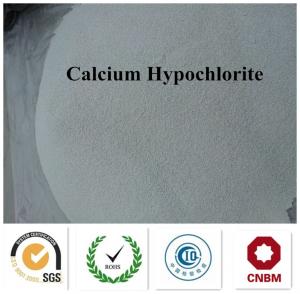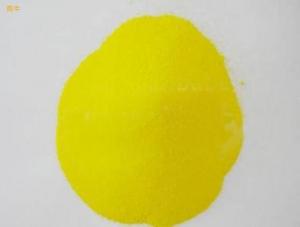Water treatment material Polyaluminium ferric chloride
- Loading Port:
- Tianjin
- Payment Terms:
- TT OR LC
- Min Order Qty:
- -
- Supply Capability:
- 6000 m.t./month
OKorder Service Pledge
OKorder Financial Service
You Might Also Like
Water treatment material Polyaluminium ferric chloride(PAFC)
Brief introduction:
Polyaluminium ferric chloride (PAFC) is made up of aluminum salt and iron salt coagulation hydrolyzing and become
a kind of inorganic polymer coagulants, based on the principle of synergies, join the elemental iron ion or three iron
oxide and other compounds containing iron composite is a new type of high efficient coagulant.
It combines merits for aluminum salt and iron salts of aluminum ion and iron ion form has improved significantly,
polymerization degree is greatly improved. Aluminum, iron coagulant respectively of the advantages of air flotation
operation, improve the concrete performance of polyaluminium chloride; For high and low temperature and low
turbidity water water purification treatment effect is particularly evident, needn’t add alkaline additives and other
coagulant aid.
performance:
1, fast hydrolysis and weak hydration. Dense alumem ustoum, sedimentation speed.Affected by the temperature
change is small, can meet the requirements of shear force in the process of flow.
2, solid product is brown, reddish brown powder, easily soluble in water.
3, which can effectively remove the aluminum ion in the raw water and remaining free aluminum ion in water after
aluminum salts coagulation.
4, wide applicable scope, drinking water, industrial water, water, sewage and industrial wastewater treatment, etc.
5, Less dose, treatment effect is good, cut down the cost of 10-20% than other coagulants.
6, using method and packaging purposes matters is essentially same as polyaluminium chloride.
features:
1, the dosage is far lower than the traditional flocculant,the water quality is good after purification.
2, the flocculation body is formed fast, precipitation is rapid, is bigger than traditional products processing capacity.
3, the alkalinity of the water consumption, less water lower PH.
technology classification:
1, drum-type poly aluminum chloride, general aluminum content, high water insolubles, used for sewage treatment.
2, frame type poly aluminum chloride has high aluminum content, low water insolubles, used in sewage treatment
and drinking.
3, spray drying, poly aluminum chloride has high aluminum content, low water insolubles , faster dissolve. used
for potable water and higher standards water treatment.
name of index | index | |
PAFC | ||
liquid | solid | |
relative density(20°C) ≥ | 1.19 |
|
PH value(1%aqueous solution) | 3.5-4.5 | 3.5-4.5 |
(AL2O3i)content% | 10.0 | 29 |
(Fe2O3)content% | 1-2 | 2-3 |
basicity,% | 60-95 | 60-95 |
water insoluble,% < | 0.3 | 1.0 |
(As)content,% ≤ | 0.0003 | 0.0006 |
(Mn)content,% ≤ | 0.045 | 0.01 |
(SO2-)content % | 3.5-9.6 | 3.5-10 |
purposes:
Polyaluminium ferric chloride has widely scope of application: used in drinking water, industrial water, sewage
and industrial wastewater treatment, polyaluminium ferric chloride has obvious effect with all kinds of industrial
water and drinking water purification treatment.
- Q: I&#39;m said that with the increase of temperature the inorganic salts will decrease. Will that be correct?
- Usually solubility will increase with increasing temperature but there are a significant number of exceptions which show the opposite.
- Q: For science I have to find out what salts are used for but when i search a salt like lithium sulphate it always comes up with &quot;would you like to buy&quot; could you please tell me what these salts are used for*lithium sulphate*zinc nitrate*sodium phosphate
- HI I'M PNT. LITHIUM SULFATE is a white inorganic salt with the formula Li2SO4. It is used to treat bipolar disorder. It is soluble in water, though it does not follow the usual trend of solubility versus temperature — its solubility in water decreases with increasing temperature . This property is shared with few inorganic compounds, such as the lanthanoid sulfates. Lithium sulfate crystals, being piezoelectric, are also used in ultrasound-type non-destructive testing because they are very efficient sound generators. However they do suffer in this application because of their water solubility. ZINC NITRATE: Zinc nitrate (Zn(NO3)2) is a chemical compound used as a mordant in dyeing. It is also a source of zinc ions for chemistry. An example reaction gives a precipitate of zinc carbonate:Zn(NO3)2 + Na2CO3 → ZnCO3 + 2 NaNO3. Conditions/substances to avoid are: reducing agents, organic materials, metal powders, heat and flame, cyanides, sodium hypophosphite, tin(IV) chloride, phosphorus, thiocyanates, carbon, and sulfur. Its Relative Molecular Mass is 189. SODIUM PHOSPHATE: Sodium phosphate are forms of phosphorus, which is a naturally occurring substance that is important in every cell in the body. Sodium phosphate is used to treat constipation and to clean the bowel before surgery, x-rays, endoscopy, or other intestinal procedures. Sodium phosphate enemas are also used for general care after surgery and to help relieve impacted bowels. Sodium phosphate may also be used for other purposes not listed in this medication guide REGARDS, PNT.
- Q: What is inorganic salt? Lemon flavor, citric acid, is it an inorganic salt?
- Although the inorganic salt in the cell, the body content is very low, but the effect is very large, if the attention of diet diversification, eat less animal fat, eat brown rice, corn and other coarse grains, do not eat too much refined flour, Salt to maintain the normal level of citric acid is an important organic acid, also known as citric acid, no ...
- Q: citrate, What is the rationale for using a medium with this type of composition for the performance of the citrate utilization test?Thank you!
- Simmons Citrate Medium
- Q: In order to prove that magnesium is an essential salt for soybean life, two soybean seedlings with the same growth status are taken, one of them is cultured in magnesium-containing culture medium and the other is cultured in (). A. Pure water B. Sand without sand. Water containing only magnesium. Media containing no magnesium
- Biological control experiments were the only variable experiments. The question that is being explored is the variable, and the other quantities are the same. In a different amount (conditions) the same circumstances to modify a data variable in order to get the data variables on the experimental changes in the law. In order to prove that magnesium is essential for the life of soybeans, the variable is the presence or absence of magnesium. Can be designed as a magnesium-containing culture medium and magnesium-free culture medium. The other amount of the same as the amount of culture medium, soybean seedling growth status, the same number, while placed in the same place, etc., to ensure that only one variable that is the presence of magnesium.
- Q: Does the urine and urine contain inorganic salts? Anxious
- When the blood flows through the glomerular, in addition to blood cells and macromolecules of protein, the plasma part of the water, inorganic salts, glucose and urea and other substances, can be filtered through the glomeruli into the renal capsule, the formation of urine ; When the original urine through the renal tubular, which is useful for the human body substances, including most of the water, all the glucose and part of the inorganic salt, reabsorbed by the renal tubules, and into the capillaries outside the renal tube, To the blood; in the renal tubular reabsorption at the same time, renal tubular epithelial cells will produce substances (such as ammonia) secretion into the renal tubular bureaucratic, and the original urine of other waste, such as urea, part of the water and inorganic Salt, etc. from the renal tubular effusion, the formation of urine. Therefore, plasma, urine and urine are contained in the material is water, inorganic salts, urea.
- Q: Inorganic salts are not nutritious
- Nutritional substances are sugar protein fat three nutrients
- Q: what percent of dissolved salts found in seawater are minor inorganic salts, or trace?
- Seawater varies in composition a little but generally is about 3.5% salts. Of this about 3.1% is sodium chloride. So the remaining 0.4% is the other salts (Magnesium, Calcium and Potassium mostly, followed by just about every natural element in the periodic table in trace amounts)
- Q: I am told to find which bottled mineral water brands contain the most mineral salts.But im not sure if the mineral salt here is talking about the common table salt (Sodium Chloride) or the chemical salt (ionic compounds such as sulfate and chloride) or the whole list of dietary minerals (potassium, chlorine, calcium, magnesium, ect.) I normally think it is just the table salt but im afraid I might get wrong. So what is the exact definition?
- it okorder /C005969/mi... "Mineral salts are inorganic (carbon-free) elements that turn to ash when burned. "
- Q: What is the use of inorganic salts in plants? How is it discharged
- Plants need inorganic salts, just as people need trace elements, the growth of auxiliary organisms can be through the leaves of the surface of the pores, with the water discharged together
Send your message to us
Water treatment material Polyaluminium ferric chloride
- Loading Port:
- Tianjin
- Payment Terms:
- TT OR LC
- Min Order Qty:
- -
- Supply Capability:
- 6000 m.t./month
OKorder Service Pledge
OKorder Financial Service
Similar products
Hot products
Hot Searches























